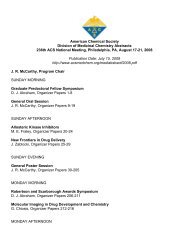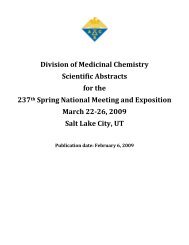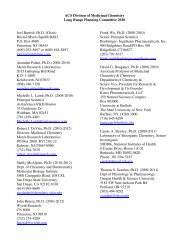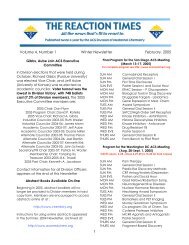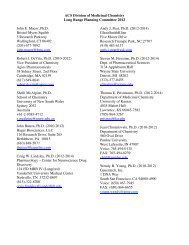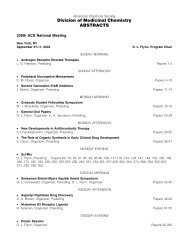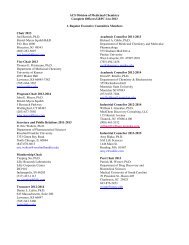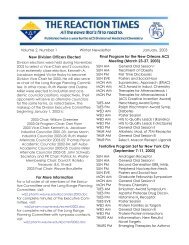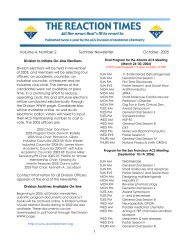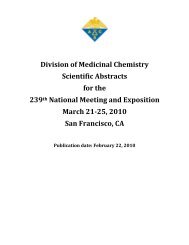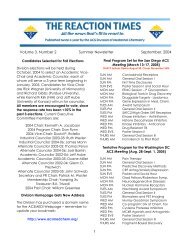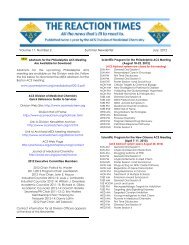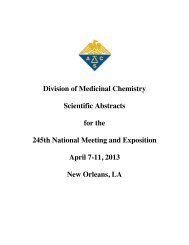Division of Medicinal Chemistry Abstracts-235th ACS National ...
Division of Medicinal Chemistry Abstracts-235th ACS National ...
Division of Medicinal Chemistry Abstracts-235th ACS National ...
- No tags were found...
Create successful ePaper yourself
Turn your PDF publications into a flip-book with our unique Google optimized e-Paper software.
MEDI 60<br />
Fluorescence detection <strong>of</strong> nucleic acids triggered by DNA-templated chemical reaction<br />
Kazuhiro Furukawa 1 , Hiroshi Abe 2 , Wang Jin 2 , Kazuma Oki 1 , Miwako Uda 1 , Satoshi Tsuneda 3 ,<br />
and Yoshihiro Ito 2 . (1) Nano Medical Engineering Laboratory, RIKEN, Waseda University, 2-1,<br />
Hirosawa, Wako-Shi, Saitama 351-0198, Japan, k-furukawa@riken.jp, (2) RIKEN, (3) Waseda<br />
University<br />
Sequence specific detection <strong>of</strong> nucleic acids is crucial for genome study, for mRNA monitoring<br />
in living cells, and for disease diagnosis. Recently, DNA-templated chemical reactions, which<br />
produce a signal as ligation process through a quenching, FRET mechanism, catalytic<br />
hydrolysis, or catalytic transfer between two probes, are becoming general approaches for the<br />
detection <strong>of</strong> oligonucleotide sequences. However, it was difficult to eliminate the background<br />
fluorescence when the target DNA or RNA was absent.<br />
Here, we developed a new nonenzymatic phosphorothioate–iodoacetyl ligation system<br />
combined with FRET system for fluorescence detection <strong>of</strong> nucleic acids. The new chemical<br />
system discriminated a single mismatch <strong>of</strong> DNAs. In addition, a novel fluorescence activation<br />
system, which minimized the background fluorescence in the absence <strong>of</strong> target DNA, was also<br />
developed.<br />
MEDI 61<br />
New fluorescence-based assays for identification and characterization <strong>of</strong> selective<br />
PPARα, δ(β), and γ ligands<br />
Upinder Singh, Bryan D. Marks, Hildegard C. Eliason, Deborah K. Stafslien, Jennifer M.<br />
Wilkinson, Therese De Rosier, Tina M. Hallis, Kurt W. Vogel, Guobin Miao, and William J.<br />
Frazee, Invitrogen Discovery Sciences, 501 Charmany Drive, Madison, WI 53719, Fax: 608-<br />
204-5200, upinder.singh@invitrogen.com<br />
The peroxisome proliferator-activated receptors (PPARs), important regulators <strong>of</strong> lipid<br />
metabolism, have three sub-types with different biological functions and tissue distributions:<br />
PPARα, δ(β), and γ. Like other nuclear receptors, the activities <strong>of</strong> the PPARs are regulated both<br />
by (endogenous or exogenous) ligands and by endogenous protein coregulators (coactivators<br />
or corepressors). We have developed new competitive binding and coregulator interaction<br />
assays for each PPAR sub-type using LanthaScreen TR-FRET technology and cellular b-<br />
lactamase reporter gene assays using GeneBLAzer® technology. Ligand binding to PPARs is<br />
detected by displacement <strong>of</strong> a fluorescent PPAR ligand (tracer) from the receptor, resulting in<br />
loss <strong>of</strong> the FRET signal between the tracer and a terbium-labeled antibody to the GST tag on<br />
PPAR. Modulation <strong>of</strong> coregulator peptide binding is detected by changes in the FRET signal<br />
between a terbium-labeled antibody and a fluorescein-labeled coregulator peptide. These<br />
assays enable the discovery and evaluation <strong>of</strong> compounds that bind to and modulate PPAR<br />
activity.



